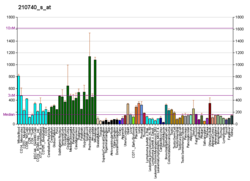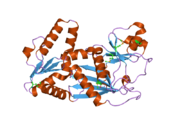| ITPK1 |
|---|
 |
| Available structures |
|---|
| PDB | Ortholog search: PDBe RCSB |
|---|
| List of PDB id codes |
|---|
2Q7D, 2ODT, 2QB5 |
|
|
| Identifiers |
|---|
| Aliases | ITPK1, ITRPK1, inositol-tetrakisphosphate 1-kinase |
|---|
| External IDs | OMIM: 601838; MGI: 2446159; HomoloGene: 8588; GeneCards: ITPK1; OMA:ITPK1 - orthologs |
|---|
| Gene location (Human) |
|---|
 | | Chr. | Chromosome 14 (human)[1] |
|---|
| | Band | 14q32.12 | Start | 92,936,914 bp[1] |
|---|
| End | 93,116,320 bp[1] |
|---|
|
| Gene location (Mouse) |
|---|
 | | Chr. | Chromosome 12 (mouse)[2] |
|---|
| | Band | 12|12 E | Start | 102,534,841 bp[2] |
|---|
| End | 102,671,189 bp[2] |
|---|
|
| RNA expression pattern |
|---|
| Bgee | | Human | Mouse (ortholog) |
|---|
| Top expressed in | - C1 segment
- right frontal lobe
- anterior cingulate cortex
- prefrontal cortex
- amygdala
- nucleus accumbens
- sural nerve
- Brodmann area 9
- right coronary artery
- caudate nucleus
|
| | Top expressed in | - gastrula
- choroid plexus of fourth ventricle
- decidua
- crypt of lieberkuhn of small intestine
- intestinal villus
- ileum
- duodenum
- jejunum
- epithelium of small intestine
- CA3 field
|
| | More reference expression data |
|
|---|
| BioGPS | 
 | | More reference expression data |
|
|---|
|
| Gene ontology |
|---|
| Molecular function | - transferase activity
- nucleotide binding
- isomerase activity
- metal ion binding
- kinase activity
- inositol-1,3,4,5,6-pentakisphosphate 1-phosphatase activity
- catalytic activity
- inositol-1,3,4,6-tetrakisphosphate 6-phosphatase activity
- inositol-1,3,4,6-tetrakisphosphate 1-phosphatase activity
- inositol-3,4,6-trisphosphate 1-kinase activity
- ATP binding
- hydrolase activity
- magnesium ion binding
- inositol-1,3,4-trisphosphate 6-kinase activity
- inositol-1,3,4,5-tetrakisphosphate 5-phosphatase activity
- inositol-1,3,4-trisphosphate 5-kinase activity
- inositol tetrakisphosphate 1-kinase activity
- inositol tetrakisphosphate 6-kinase activity
| | Cellular component | - cytosol
- intracellular anatomical structure
- apical plasma membrane
- cytoplasm
| | Biological process | - phosphorylation
- blood coagulation
- inositol phosphate metabolic process
- inositol trisphosphate metabolic process
- neural tube development
- signal transduction
- dephosphorylation
- necroptosis
- inositol phosphorylation
| | Sources:Amigo / QuickGO |
|
| Orthologs |
|---|
| Species | Human | Mouse |
|---|
| Entrez | | |
|---|
| Ensembl | |
|---|
ENSG00000100605
ENSG00000274958 |
| |
|---|
| UniProt | | |
|---|
| RefSeq (mRNA) | |
|---|
NM_014216
NM_001142593
NM_001142594
NM_001363707 |
| |
|---|
| RefSeq (protein) | |
|---|
NP_001136065
NP_001136066
NP_055031
NP_001350636 |
| |
|---|
| Location (UCSC) | Chr 14: 92.94 – 93.12 Mb | Chr 12: 102.53 – 102.67 Mb |
|---|
| PubMed search | [3] | [4] |
|---|
|
| Wikidata |
| View/Edit Human | View/Edit Mouse |
|

 2odt: Structure of human Inositol 1,3,4-trisphosphate 5/6-kinase
2odt: Structure of human Inositol 1,3,4-trisphosphate 5/6-kinase




















